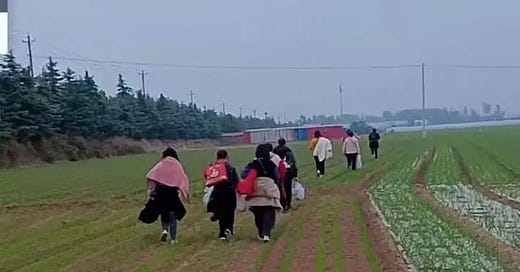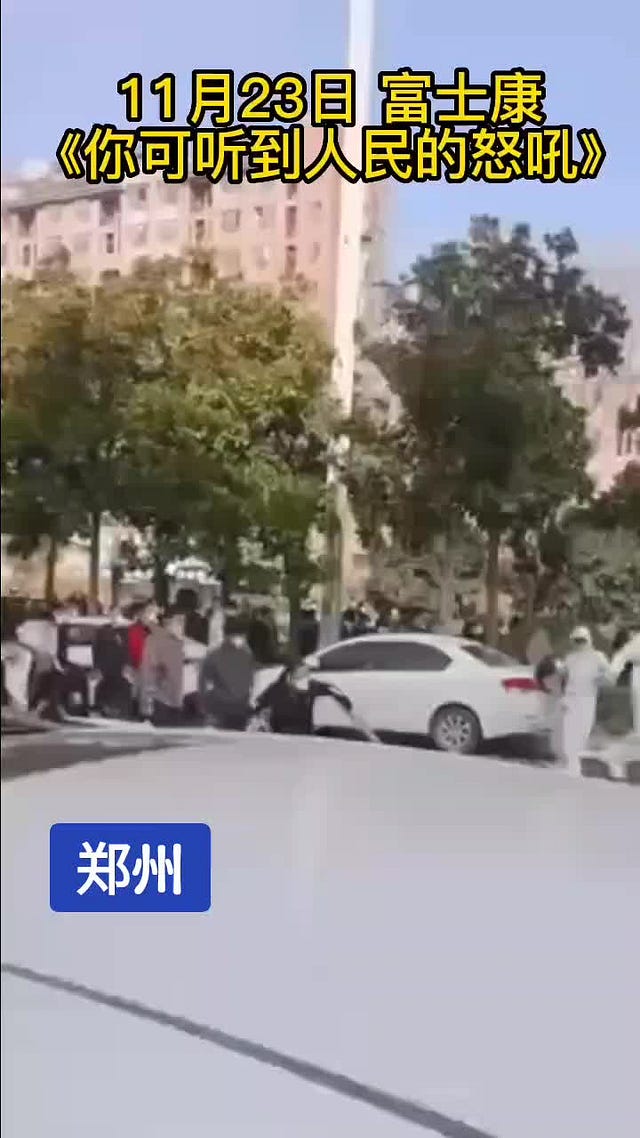Visual Stories on Labor from China: The Foxconn Exodus + Migrant in the Mood for Love + Lifetime in an Abandoned Mine
Issue #13: In this two-part series, we'll explore the topic of labor from reportage to personal essays.
Hi there,
It’s Yan, Beimeng, and Charlotte here.
In late October, photos on social media showed workers fleeing Foxconn factories in Zhengzhou, facilities that account for 85% of global iPhone assembly capacity. A Covid outbreak had forced the plant to lock down, leading anxious workers—worried about food shortages and infections—to take to the road. All transport had been halted, and so we saw striking photos of workers trekking on highways and through farm fields, their luggage trailing behind. As we write this on November 23, protests have erupted again among newly recruited workers over compensation, growing into a violent clash with riot police clad in all-white protective suits.
These images and videos inspired us to put together two issues that explore the topic of labor in China, from reportage uncovering working conditions to personal stories of people reflecting on their relationship to labor.
Among them is a moving short doc about a middle-aged domestic worker’s pursuit of love and fashion as self-expression. There’ll also be a story in the next issue about an artist honoring her mother’s labor by secretly purchasing all the hats she knitted.
After this two-parter, we'll also have a gift guide for you as we enter the holiday season. Subscribe now to get these new issues directly in your inbox.
As always, if you like the work we do at Far & Near, consider making a donation. For the price of a cup of coffee, you can help us continue our work. Learn more about our mission and membership model here.
The Foxconn Exodus
At the end of October, photos and videos like the ones above showed hordes of Foxconn workers climbing over iron fences and walking across rice fields to travel home. They went viral on the Chinese internet. Social media posts even captured local villagers setting up supply stations en route.
It was through these stories that the Chinese public learned about a COVID outbreak inside the world’s biggest iPhone assembler. The sprawling plant, located in Zhengzhou, Henan Province, employs more than 200,000 workers. Although the plant’s spokesperson denied that a mass outbreak had occurred, social media footage and personal accounts reveal the chaos caused by workers’ fear of getting infected, suffering food shortages, and living through a lack of transparency under strict quarantine.
After thousands of workers fled and the government responded by promising safe conditions, 100,000 workers were reportedly recruited back in a massive hiring drive in a matter of weeks. Even civil servants and retired soldiers were mobilized to join Foxconn’s workforce to ensure production deadlines were met. But these grand narratives soon fell apart, as footage from this week showed violent clashes between riot police dressed in all-white protective suits and angry new hires who said Foxconn had changed the terms of their pay after luring them to the factory.
 Tiktok failed to load.
Tiktok failed to load.Enable 3rd party cookies or use another browser
The visuals highlight something that’s long been neglected: the fate of individual workers caught between the insatiable demands of global capitalism and the merciless impositions of zero-COVID policy.
As Chinese media became increasingly absent in covering these critical issues, either unable to reach the scenes of quickly-evolving news events due to Covid restrictions or out-right barred from reporting on them, these visuals shared by individuals on social media stepped in to raise public awareness and hold people in power accountable.

Speaking of change, we’d like to update you on something that offers a little hope, however rare it is — in issue 11, we featured a video story about Xi’an homeowners forced to live in their unfinished apartments at the height of a real estate crisis. The video garnered millions of views, and news came in last week that the apartments were finally finished, after an 8-year pause on construction. Producer Zheng Haipeng, behind the video linked above, shared his thoughts with us:
“As a producer at iFeng’s FACE, the "traffic" for each video matters a lot to me. In the current media ecosystem, traffic = attention. Only via public attention can there be some chance of bringing change. The video provided a space for the public to vent their emotions and made people believe that there are still media outlets out there that care about their struggles and listen to their stories. Luckily, the unprecedented attention the story received directly resulted in construction being resumed in a very short period of time... But many homeowners still face a dilemma because they had to pay extra fees to have the construction continue. During this period, homeowners in many cities came to us, hoping to change their lives through similar coverage. Personally, I feel powerless not knowing how to help them.”
2. Migrant in the Mood for Love
During the day, Qu Zixin juggles two jobs, working as a domestic worker and as staff in a ghost kitchen. In the evening, she puts on a pretty dress and goes out to dance parties and karaoke nights organized by middle-aged singles.
Qu, now in her 50s, separated from her husband in 2009 and moved to Beijing to find work. She ended up as a domestic worker in different homes in Beijing. While many migrant domestic workers in Beijing share similar stories like her, what makes Qu stand out is her unflinching pursuit of love and joy despite hardships.
Eager to meet people, Qu is a regular at singles parties, where the main function is to help lonely, middle-aged and elderly people socialize and find partners. But these parties can also be laborious, where the desire for connection is met with pragmatism, sexual advances, and even scams. Sometimes, Qu’d rather invest her attention in clothing than connection, be it a leopard print blazer or a purple velvet dress. Filmmaker Chen Jiani portrays Qu’s life with care and sensitivity, telling a story not of a “migrant worker” but of a woman who longs for love and has a right to it.
Watch Chen’s film here.
3. Life as a Watchman in an Abandoned Guizhou Mine
Hidden in the mountains of southwestern Guizhou province are the ruins of what used to be Asia’s largest mercury reserves. These mercury mines created the area’s industrial boomtowns in the 1970s. After the reserves were depleted and the mines shut in the 1990s, former miners were found to suffer from “high rates of divorce, unemployment, drug-taking, and mercury poisoning,” according to a China Dialogue report.
Lü Meng’s story looks into the isolated life of one such miner, 57-year-old Yang Shigui, who has stayed on as a watchman after the mine and many of its facilities were abandoned. Yang’s 3,000 yuan salary isn’t attractive, but he also has nowhere to go. A second-generation miner, he has spent his entire life working there. Now divorced, and besides occasional visits to his elderly mother, he is kept company only by a stray goose that he feeds. Lü’s photos not only depict Yang’s life, but also the things that were left behind at the abandoned site: a hat, a chopsticks container, and a piece of torn curtain hanging on the window—evidence of a bygone era.
View Lü’s images here.
Who we are:
Yan Cong is formerly a photojournalist currently pursuing a research MA in new media and digital culture in Amsterdam.
Beimeng Fu is a video journalist based in Shanghai. She is a lover of languages and documentaries.
Ye Charlotte Ming is a journalist and visuals editor covering stories about culture, history, and identity. She’s based in Berlin and working on a book about her hometown’s German colonial past.
Writers: Beimeng Fu and Yan Cong; Editor: Ye Charlotte Ming; Copy editor: Krish Raghav
Have a comment or just want to say hello? Drop us a line at yuanjinpj@gmail.com. You can also find us on Twitter.
Liked our content? Become a paid subscriber of Far & Near and forward it to a friend!








